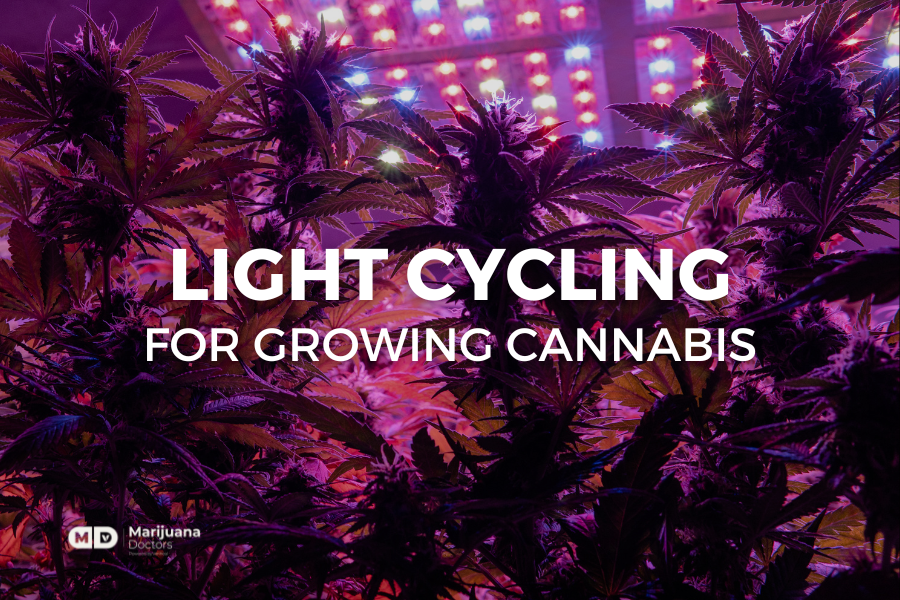
Regardless of whether you grow indoors or outdoors, your cannabis plants will adhere to two standard light cycles, with the exception of auto-flowering cannabis seeds. Unlike regular cannabis seeds or clones, auto-flowering cannabis seeds are typically left under a 20-hour light cycle from seed to harvest. All other varieties of cannabis require two different light cycles in order to grow properly.
You can do different things during these light cycles to increase the productivity of your plants, such as adding nutrients, altering lighting, and monitoring the pH levels of water and soil. Regardless of your technique, you’ll need to know about the vegetative and flowering light cycles.
Cannabis plants in an outdoor environment are typically planted in early spring. This gives them several months to grow outdoors before the light cycle starts to change naturally. During summer days, plants will get tall and bushy, producing multiple bud points. As autumn approaches and the days get shorter, cannabis plants naturally begin to flower, starting to show hairs, and the formation of buds begins. This change is brought on by the change in the light cycle going to shorter days.
This is the same thing that happens in an indoor environment, with the exception that multiple crops are grown in one year instead of one. Cycling just one tent, you can produce an indoor crop every three to four months, giving you three to four indoor grows yearly. Cannabis plants are put under a consistent light cycle for a certain amount of time, such as 18 hours on and 6 hours off, known simply as an 18/6 light cycle. Once the time is right, the cycle is then switched to a 12/12 cycle, triggering the cannabis plants to begin flowering. It is important to make sure you have the right amount of light for the grow space you will be using when growing indoors.
Different growers choose different light cycles, but during the vegetation stage, the light cycle most people choose is 18/6. This means your lights are on for 18 hours and off for 6 hours at a scheduled time consistently during the vegetation stage of your plants. An interruption in this light cycle can cause stress to cannabis plants.
Growers often choose to use different lights for the vegetation stage vs. flowering. Veg lights often have a bluish tone to them and put off a softer light. A lot of the full spectrum LED grow lights available on the market today offer options for veg lights, flowering lights, and many offer a third option, which combines both.
Cannabis plants will remain in the vegetation stage as long as the light cycle stays at 18/6. For many varieties of cannabis, 6-8 weeks is the average amount of time they will spend under the vegetative light cycle. Somewhere between the six to eight-week mark, the light cycle will be switched to what is called the flowering cycle.
The flowering light cycle is when we change the time the light spends on and off to equal amounts. The flowering cycle is 12-12, having 12 hours of light and 12 hours of total darkness. The 12 hours of total darkness is important. If plants are exposed to even pinholes of light or light pollution from streetlights or yard lights, they can end up stressed, which is a common cause for plants turning male.
When the flowering light cycle comes up, it is common for growers to use a rich or more intense light that has more of a red tone in it. Wattage is often increased to lights during this period, especially when HPS setups with ballasts are being used. Most varieties of cannabis are ready for harvest between 8 to 10 weeks under the flowering lights.
Once cannabis plants are placed under the flowering light cycle, they must remain under this light cycle until harvest. The only exception is that some growers choose to do a total blackout for 72 hours before plants are harvested. When this technique is implored, it is often used in conjunction with cool temperatures to help bring out flavor and terpene profiles in cannabis plants before harvest.
Different cannabis strains will require different grow times. It is important to familiarize yourself with veg and flower times on any cannabis genetics you are considering cultivating. Knowing these will help you plan your light cycle accordingly.
It’s important to remember all grow lights aren’t created equally. They might say a thousand watts of full spectrum LED, but chances are they don’t actually put out that much light. Most 4×4 grow tents require around 1200 to 2000 watts of light to cultivate cannabis plants properly. Not enough light will make your plants tiny, thin, and frail. Too much light and you’ll burn your plants. It is also important to make sure that lights are hung at the proper distance from the top of your canopy.
This means understanding what type of lighting you’re using and the recommended distance for that light between plants during vegetation and flowering stages. Full spectrum LED lights can be moved closer to plants than other light varieties because they produce less heat. You still have to be careful of light burn though. As you can see, there’s a little more to it than just turning the lights off and on. The best way to learn is to get your hands dirty and start growing medicinal cannabis today.
No Information on MarijuanaDoctors.Com should be used to diagnose, treat, prevent or cure any disease or condition. You can view our Full Disclaimer here.